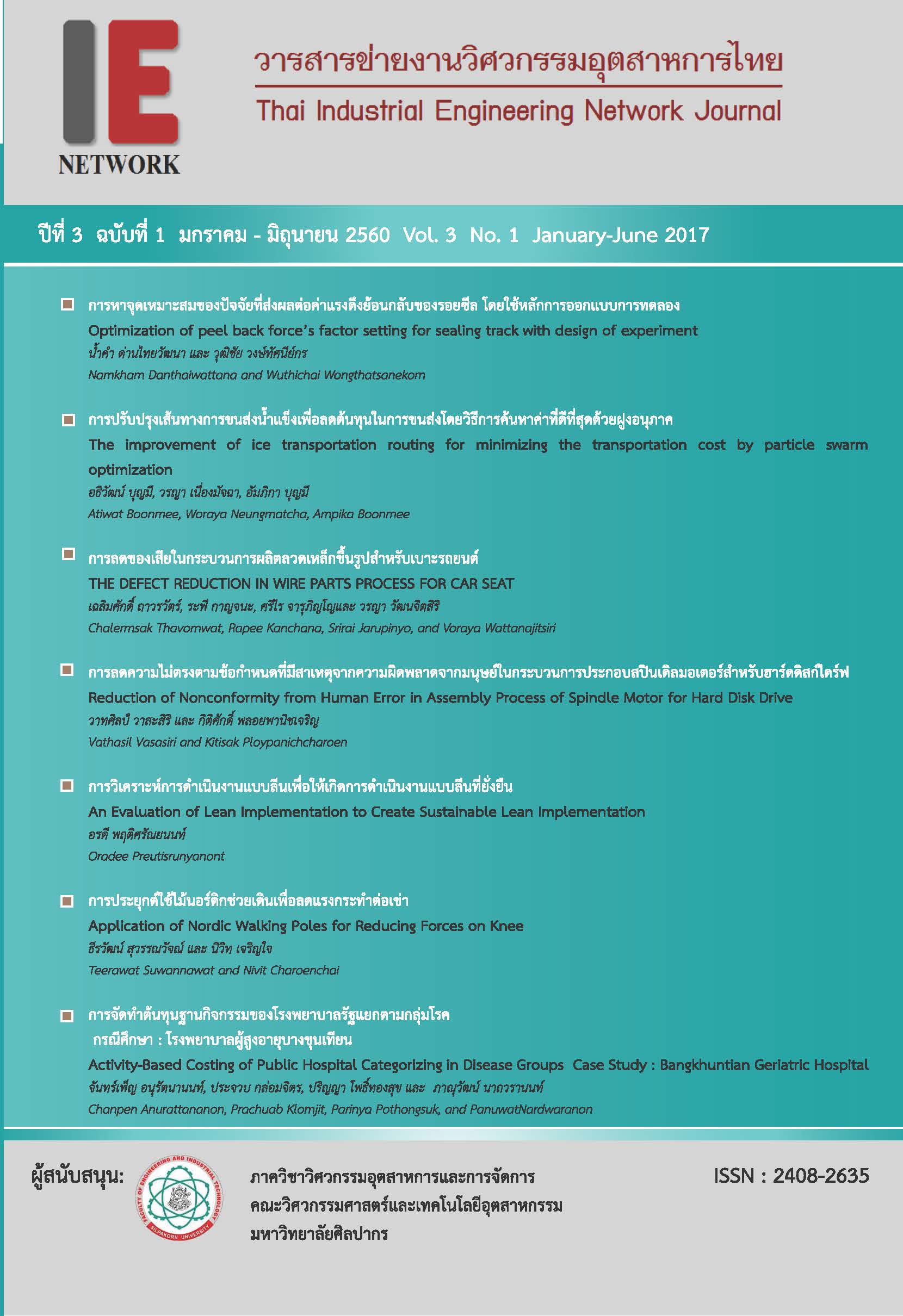Application of Nordic Walking Poles for Reducing Forces on Knee
Main Article Content
Abstract
The purpose of this research was to determine the parameters of Nordic poles effected on knee during walking. Experiments were done on 20 male volunteers. Full factorial design (2k) were analyzed on two levels of three factors which were the height of Nordic poles (elbow angle 90 degree, elbow angle less than 90 degree), walking speed (normal walk, brisk walk), ground contact (two point contact ground, three point contact). Ground force reaction measured from motion analyzer and force plate with the frequency of 1 per 100 second. Then biomechanical analysis on one cycle walk on sagittal plane was identified and analyzed to determine the factors that effected on knee during walking with Nordic poles. The results has shown that minimum ground reaction force on knee (fz1) of optimize parameters which were walking speed on low speed (Lower 2 m.s-1), ground contract on one method (two point contract ground), and height of Nordic poles on
low level (elbow angle 90 degree). In addition to compare with walking without Nordic poles, ground reaction force on knee (Fz1) to be decreased 3.90%
Article Details
บทความ ข้อมูล เนื้อหา รูปภาพ ฯลฯ ที่ได้รับการตีพิมพ์ในวารสารฯ ถือเป็นลิขสิทธิ์ของวารสารฯ หากบุคคลหรือหน่วยงานใดต้องการนำทั้งหมดหรือส่วนหนึ่งส่วนใดไปเผยแพร่ต่อหรือเพื่อกระทำการใดๆ จะได้รับอนุญาต แต่ห้ามนำไปใช้เพื่่อประโยชน์ทางธุรกิจ และห้ามดัดแปลง
References
[2] van Eijkeren F. J., Nordic walking improves mobility in Parkinson's disease, Movement Disorders, 2008
[3] Reuter I., Effects of a flexibility and relaxation programme walking and nordic walking on Parkinson's disease, Journal of aging research, 2011
[4] Schwameder, H., Knee joint forces during downhill walking with hiking poles, Journal of sports sciences, 1999
[5] Fregly B. J., Effective gait patterns for offloading the medial compartment of the knee, Journal of Orthopaedic Research, 2009
[6] Dziuba, A.K., Biomechanical parameters in lower limbs during natural walking and Nordic walking at different speeds, Acta of bioengineering and biomechanics 17, 2015
[7] David Hudson, The Effect of Walking With Poles on the Distribution of Plantar Pressures in Normal Subjects, PM&R, 2014
[8] Kocur P., Nordic Walking—a new form of exercise in rehabilitation, Medical Rehabilitation, 2006
[9] กิตติ อินทรานนท์, การหามวลของส่วนต่างๆของร่างกายและจุดศูนย์กลางมวล, โครงงานวิจัยเลขที่ 146-1R-2543, 2543
[10] Kovac, I., Ground Reaction Force Analysis in Traumatic Transtibial Amputees’ Gait. Collegium antropologicum, 2009
[11] Thorwesten, L., Ground reaction forces in nordic Walking and Walking, In ISBSConference Proceeding Archive, 2007
[12] Willson. J., Effects of walking poles on lower extremity gait mechanics, Medicine and science in sport and exercise 33, 2001
[13] เอกพล ริยะกาศ, ผลของการออกกำลังกายด้วยการเดินแบบนอร์ดิกต่อความรุนแรงของโรคในผู้สูงอายุโรคข้อเข่าเสื่อม, วารสารสภาการพยาบาล ปีที่ 30 ฉบับที่ 4, 255


